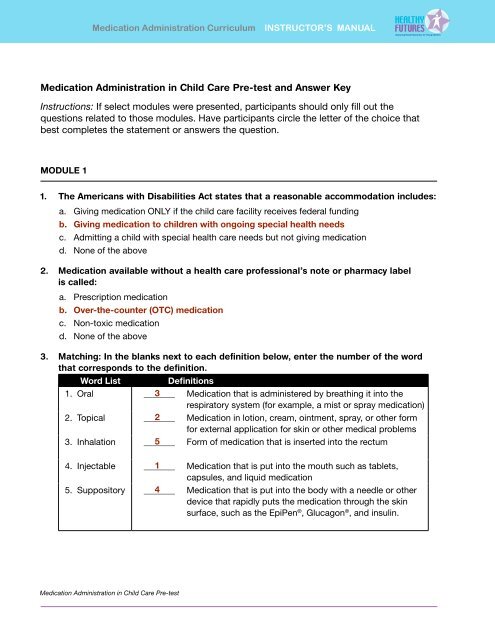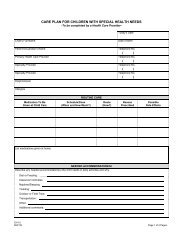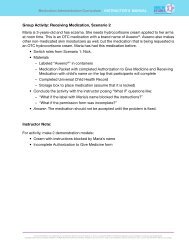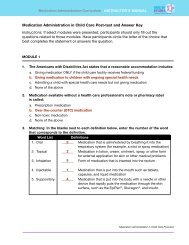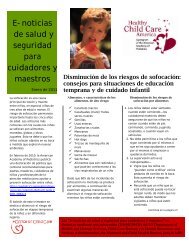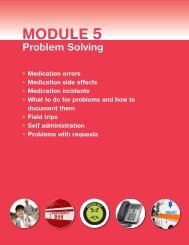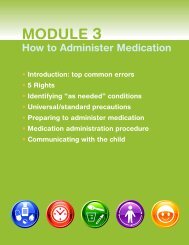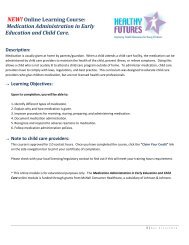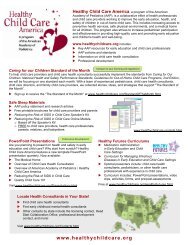Medication Administration in Child Care Pre-test and Answer Key ...
Medication Administration in Child Care Pre-test and Answer Key ...
Medication Administration in Child Care Pre-test and Answer Key ...
You also want an ePaper? Increase the reach of your titles
YUMPU automatically turns print PDFs into web optimized ePapers that Google loves.
<strong>Medication</strong> <strong>Adm<strong>in</strong>istration</strong> Curriculum INSTRUCTOR’S MANUAL<strong>Medication</strong> <strong>Adm<strong>in</strong>istration</strong> <strong>in</strong> <strong>Child</strong> <strong>Care</strong> <strong>Pre</strong>-<strong>test</strong> <strong>and</strong> <strong>Answer</strong> <strong>Key</strong>Instructions: If select modules were presented, participants should only fill out thequestions related to those modules. Have participants circle the letter of the choice thatbest completes the statement or answers the question.MODULE 11. The Americans with Disabilities Act states that a reasonable accommodation <strong>in</strong>cludes:a. Giv<strong>in</strong>g medication ONLY if the child care facility receives federal fund<strong>in</strong>gb. Giv<strong>in</strong>g medication to children with ongo<strong>in</strong>g special health needsc. Admitt<strong>in</strong>g a child with special health care needs but not giv<strong>in</strong>g medicationd. None of the above2. <strong>Medication</strong> available without a health care professional’s note or pharmacy labelis called:a. <strong>Pre</strong>scription medicationb. Over-the-counter (OTC) medicationc. Non-toxic medicationd. None of the above3. Match<strong>in</strong>g: In the blanks next to each def<strong>in</strong>ition below, enter the number of the wordthat corresponds to the def<strong>in</strong>ition.Word List Def<strong>in</strong>itions1. Oral 3 <strong>Medication</strong> that is adm<strong>in</strong>istered by breath<strong>in</strong>g it <strong>in</strong>to therespiratory system (for example, a mist or spray medication)2. Topical 2 <strong>Medication</strong> <strong>in</strong> lotion, cream, o<strong>in</strong>tment, spray, or other formfor external application for sk<strong>in</strong> or other medical problems3. Inhalation 5 Form of medication that is <strong>in</strong>serted <strong>in</strong>to the rectum4. Injectable 1 <strong>Medication</strong> that is put <strong>in</strong>to the mouth such as tablets,capsules, <strong>and</strong> liquid medication5. Suppository 4 <strong>Medication</strong> that is put <strong>in</strong>to the body with a needle or otherdevice that rapidly puts the medication through the sk<strong>in</strong>surface, such as the EpiPen ® , Glucagon ® , <strong>and</strong> <strong>in</strong>sul<strong>in</strong>.<strong>Medication</strong> <strong>Adm<strong>in</strong>istration</strong> <strong>in</strong> <strong>Child</strong> <strong>Care</strong> <strong>Pre</strong>-<strong>test</strong>
<strong>Medication</strong> <strong>Adm<strong>in</strong>istration</strong> Curriculum INSTRUCTOR’S MANUALModule 24. Your facility policy should <strong>in</strong>clude all of the follow<strong>in</strong>g:a. Who will adm<strong>in</strong>ister medication <strong>and</strong> who the alternate person will beb. What medication will be givenc. Where <strong>and</strong> how medication will be storedd. Procedure for medication error or <strong>in</strong>cidente. All of the above5. A mother br<strong>in</strong>gs <strong>in</strong> some chewable tablets that she took from a bottle of medicationthat she says her daughter’s health care professional prescribed the day before.The mother is keep<strong>in</strong>g the ma<strong>in</strong> supply of the medication at home. She fills out theprogram forms to give permission to the staff to give the medication at noon to herchild. What is the most appropriate th<strong>in</strong>g for the child care provider to do?a. Call the health care professional immediately to see if it is okay to give the medicationb. Give the medication to the child if it looks/smells okayc. Refuse to give the medicationd. Don’t know6. When receiv<strong>in</strong>g a medication you should:a. Match the label with permissions <strong>and</strong> <strong>in</strong>structionsb. Ask the parent/guardian about successful techniques that he has used to adm<strong>in</strong>ister themedicationc. Ask the parent/guardian about when the medication was last adm<strong>in</strong>isteredd. All of the above7. A guardian br<strong>in</strong>gs you medication for her child. After receiv<strong>in</strong>g the medication, yournext step should be to:a. Sort the medication for ease of deliveryb. Log <strong>in</strong> medication <strong>and</strong> store itc. Adm<strong>in</strong>ister the medication with<strong>in</strong> the next 3 hoursd. Don’t know8. All of the follow<strong>in</strong>g are steps <strong>in</strong> the process of receiv<strong>in</strong>g medications EXCEPT:a. Match the label with the <strong>in</strong>structionsb. Check if conta<strong>in</strong>er is labeled child-resistantc. Check expiration dated. Ensure that the child receives a dose that same day<strong>Medication</strong> <strong>Adm<strong>in</strong>istration</strong> <strong>in</strong> <strong>Child</strong> <strong>Care</strong> <strong>Pre</strong>-<strong>test</strong>
<strong>Medication</strong> <strong>Adm<strong>in</strong>istration</strong> Curriculum INSTRUCTOR’S MANUALModule 39. Ways to tell if you have the Right child <strong>in</strong>clude all of the follow<strong>in</strong>g EXCEPT:a. Know<strong>in</strong>g the child from your experienceb. Ask<strong>in</strong>g the child if she is the name that appears on the labelc. Hav<strong>in</strong>g a photo of the child attached to the medication adm<strong>in</strong>istration paperworkd. Hav<strong>in</strong>g another staff member who is familiar with the child verify her identity10. Adm<strong>in</strong>ister<strong>in</strong>g the Right dose of medication <strong>in</strong>volves all of the follow<strong>in</strong>g EXCEPT:a. Check<strong>in</strong>g the label <strong>and</strong> the permission form to see if they match.b. Us<strong>in</strong>g a measur<strong>in</strong>g devicec. Verify<strong>in</strong>g the dose with the childd. Check<strong>in</strong>g the measur<strong>in</strong>g device at eye level11. Which of the follow<strong>in</strong>g is an example of an “as needed medication”?a. Tylenol ® for feverb. Albuterol ® for wheez<strong>in</strong>gc. Amoxicill<strong>in</strong> for ear <strong>in</strong>fectiond. A <strong>and</strong> Be. All of the above12. A child refuses to take her medication. In order to get the child to comply, youconsider mix<strong>in</strong>g the medication with her favorite beverage. Before do<strong>in</strong>g so youshould:a. Split the medication <strong>in</strong>to 2 doses to ensure that the child takes her full dosageb. Check with the health care professional or pharmacist before mix<strong>in</strong>g medicationswith food or beveragesc. Give the child a small portion of the beverage prior to mix<strong>in</strong>g the medication <strong>in</strong>to itd. None of the above13. A young toddler <strong>in</strong> your care is refus<strong>in</strong>g to take a dose of antibiotic. You should:a. Mix it <strong>in</strong> the child’s bottleb. Hold his nose until he opens his mouthc. Refuse to give the child the medicationd. Give the child the choice of what dr<strong>in</strong>k he wants after tak<strong>in</strong>g the medication<strong>Medication</strong> <strong>Adm<strong>in</strong>istration</strong> <strong>in</strong> <strong>Child</strong> <strong>Care</strong> <strong>Pre</strong>-<strong>test</strong>
<strong>Medication</strong> <strong>Adm<strong>in</strong>istration</strong> Curriculum INSTRUCTOR’S MANUALModule 414. Please read the scenario <strong>and</strong> enter the <strong>in</strong>formation <strong>in</strong>to the medication log below.Scenario: Today, you give Nick one 125 mg capsule of Depakote ® spr<strong>in</strong>kles at 12:00 PM.<strong>Medication</strong> LogPAGE 3—TO BE COMPLETED BY CAREGIVER/TEACHERName of child _____________________________________________________Weight of child____________________Medic<strong>in</strong>eMonday Tuesday Wednesday Thursday FridayDate / / / / / / / / / /Actual time givenAM __________AM __________AM __________AM __________AM __________PM __________PM __________PM __________PM __________PM __________Dosage/amountRouteStaff signature<strong>Medication</strong> <strong>Adm<strong>in</strong>istration</strong> <strong>in</strong> <strong>Child</strong> <strong>Care</strong> <strong>Pre</strong>-<strong>test</strong>
<strong>Medication</strong> <strong>Adm<strong>in</strong>istration</strong> Curriculum INSTRUCTOR’S MANUALModule 515. Upset stomach, diarrhea, dry mouth, changes <strong>in</strong> mood, <strong>and</strong> drows<strong>in</strong>ess after tak<strong>in</strong>g amedication are all examples of:a. Effective medicationb. <strong>Medication</strong> errorsc. Side effectsd. Overdose of medication16. When call<strong>in</strong>g Poison Control, you should have which of the follow<strong>in</strong>g <strong>in</strong>formationavailable?a. The medication conta<strong>in</strong>erb. The child’s current weightc. The child’s Emergency Contact Formd. All of the abovee. None of the above17. In which of the follow<strong>in</strong>g situations should Poison Control be called:a. The child refuses to take his medicationb. You give the wrong medication to a childc. You give a medication to the wrong childd. B <strong>and</strong> C18. A child takes his medication <strong>in</strong> his mouth <strong>and</strong> then spits it out. What actions should beperformed?a. Notify the parent/guardianb. Repeat the dosec. Fill out a medication <strong>in</strong>cident reportd. A <strong>and</strong> Ce. All of the above19. It is 2:00 PM <strong>and</strong> you realize that you forgot to give a dose of medication that was dueat 12:00 PM. The first th<strong>in</strong>g you should do is:a. Give the dose right awayb. Document the missed dose <strong>and</strong> notify the parentc. Contact the child’s doctord. Contact the pharmacy to get the pharmacist’s advice<strong>Medication</strong> <strong>Adm<strong>in</strong>istration</strong> <strong>in</strong> <strong>Child</strong> <strong>Care</strong> <strong>Pre</strong>-<strong>test</strong>


